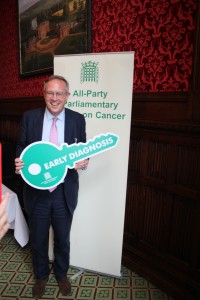MP highlights new figures measuring earlier diagnosis at CCG level
Yesterday the Chairman of the All-Party Parliamentary Group on Cancer (APPGC), John Baron MP, hosted a Parliamentary reception attended by MPs, Peers, Clinical Commissioning Group (CCG) Chief Officers and charity representatives. John spoke at the event, which was also addressed by the Minister with responsibility for cancer, Jane Ellison MP, and the National Clinical Director for Cancer, Sean Duffy.
The reception marked the success of the APPGC and wider cancer community in getting crucial one-year cancer survival data presented in the Clinical Commissioning Group (CCG) Outcomes Indicator Set (OIS), the measure that monitors CCGs’ priorities and improvements. By putting one-year survival rates up in lights, CCGs will be able to identify where progress is vitally needed and make strides towards improving survival – as late diagnosis makes for poor survival rates.
The UK lags far behind its international and European neighbours in cancer survival2. The APPGC believes that this must change. By 2020, almost half of people will receive a cancer diagnosis during their lifetime3. Cancer survival rates in the UK are among the worst in Europe – not least because many people are diagnosed too late.
At the event, MPs were presented with the cancer survival rates in their local area. In Basildon and Billericay 70% of people with cancer will live for a year after diagnosis.
John said,
“Yesterday was a great success, with a large number of MPs, Peers and the whole cancer community in attendance. I would like to express my thanks to Jane Ellison MP and Sean Duffy for speaking at the event.”
“We know that early diagnosis of cancer often leads to better survival rates for patients. The one-year cancer survival rates in our area will help residents to see how the CCG is performing and demand improvements. As the MP, I will continue to question our CCG as to how we can drive up earlier diagnosis.”
“In Basildon and Billericay, only 70% of people live for a year or more after a cancer diagnosis.[1] More work is needed through earlier diagnosis to increase this number, as the UK still has among the lowest survival rates in Europe. Better screening uptake, diagnostics at Primary Care, public awareness and GP training are all possible initiatives our local CCG could introduce. Hundreds of lives each year could be saved as a result.”
[1] One-year net cancer survival index – adjusted for age, sex, cancer type and background mortality. ONS and London School of Hygiene and Tropical Medicine, 2013, Cancer Survival Index for Clinical Commissioning Groups, Adults Diagnosed 1996-2011 and Followed up to 2012 (http://www.ons.gov.uk/ons/rel/cancer-unit/a-cancer-survival-index-for-clinical-commissioning-groups/adults-diagnosed-1996-2011-and-followed-up-to-2012/index.html accessed April 2014)
2 De Angelis R, Sant M, Coleman MP, et al. Cancer survival in Europe 1999–2007 by country and age: results of EUROCARE-5—a population-based study. Lancet Oncol 2013; published online Dec 5. http://dx.doi.org/10.1016/S1470-2045(13)70546-1
3. Macmillan estimates based on; prevalence projections to 2020 from Maddams J, Utley M, Møller H. Projections of cancer prevalence in the United Kingdom, 2010-2040. Br J Cancer 2012; 107: 1195-1202. (Scenario 1); Incidence and mortality (cancer) projections estimated to 2020 assume trends from 2000 to 2010 continue at the same rate (except for prostate cancer where static incidence rates were assumed from 2009 to 2030) in line with prevalence projections. 2000 to 2010 data are provided by Office for National Statistics (England); Information Services Division (ISD) Scotland; General Registrar Office Scotland; Welsh Cancer Intelligence & Surveillance Unit; Northern Ireland Cancer Registry; all cause mortality projection estimates to 2030 taken from Office for National Statistics (UK). For prostate cancer incidence projections, 2009 incidence rates (UK) by broad age group taken from the UKCIS were applied to population projections (UK) from Office for National Statistics to project incidence to 2030.

John Baron will not post replies to any comments - to contact John please Click here or alternatively for a full list of contact details Click here